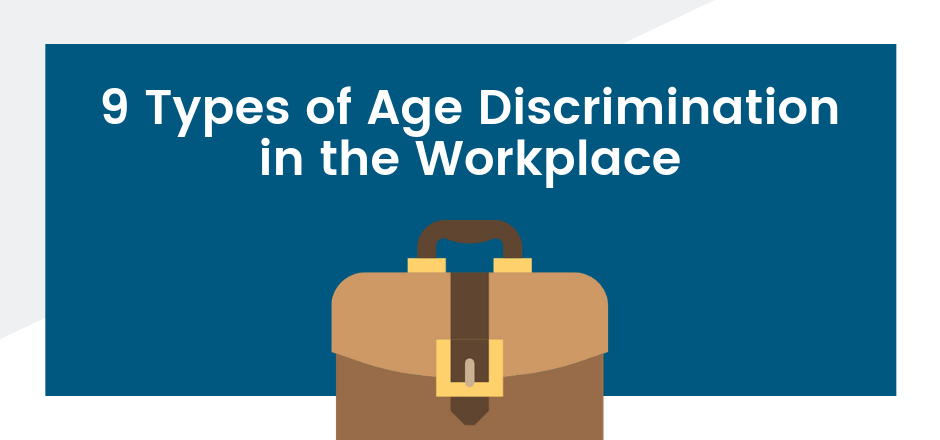9 Types of Age Discrimination in the Workplace
If you’re not being treated fairly at work because of your age, you might be experiencing age discrimination in the workplace. This is considered a serious issue in California, so you may want to consider seeking legal guidance to evaluate your situation. To help you get started, we’re taking a closer look at some of the most common examples of age discrimination.
Here are 9 types of age discrimination in the workplace.

Types of Age Discrimination in the Workplace
One research study involving more than 1,500 older adults showed that almost two-thirds of them said they have seen or experienced age discrimination in the workplace. And of those, over 90 percent said it is a common occurrence.
The federal government recognized the seriousness of discrimination and in 1967 created the Age Discrimination in Employment Act (ADEA) which forbids age discrimination against people aged 40 and older. This Act protects workers from personnel decisions based solely on age in hiring, layoffs or firing, promotions or demotions. The act applies to all private-sector employers with at least 20 workers. And it applies to all government organizations of any size.
Examples of Age Discrimination
So what is age discrimination? How can you recognize it? And what can you do about it?
Here are several common examples of age discrimination.
- Harassment
- Favoritism
- Unfair Discipline
- Denied Promotion
- You Stop Getting Raises
- Sudden Performance Review Issues
- Discriminatory Policies
- Age-specific Notices or Ads
- Age-specific Apprenticeships
If you believe you have experienced any of these examples of age discrimination, you may want to consider finding an employment lawyer. This type of lawyer specializes in the area of law pertaining to employment and will be able to guide you through the legal process.
1. Harassment and Unwelcome Comments
Employers sometimes joke with their employers in a light-hearted manner about getting older. Your boss might call you the “old man” or “grandma.” You may or may not go along with it. If you don’t like it, you should make a note of it. Write down the names of the people involved, the dates, times and places as well as the comments. Add the names of any witnesses. This can be age discrimination.
It can also be a sign of harassment – another category covered by discrimination laws. If discrimination does not affect your income (does not affect your wallet), it is called harassment. Making you feel uncomfortable or even miserable, especially with the idea that you will quit, is age discrimination.
It’s one thing for simple teasing or isolated incidents that you don’t consider serious. These are not necessarily discrimination. However, if the incidents are repeated often enough that it creates a hostile or offensive work environment, that’s something else. And if it results in demotion or dismissal, it is definitely a case of discrimination.
Harassment can come from your supervisor, another supervisor, a company officer, a coworker, or even a customer or client of the company. Any time it happens, wherever it happens, you should document it.
2. Favoritism and Unfavorable Comparisons
Are younger workers treated more favorably than you? Do you see older workers being laid off while less qualified younger workers are kept employed? This can be age discrimination, and you should document this as well.
Similarly, have you or other older workers been excluded from meetings where younger workers attended? Do you see younger employees getting better assignments, better leads, better territories or better equipment? These are also possible examples of age discrimination.
3. Unfair Discipline
If you see older workers being disciplined for doing the same things as younger workers (who were not disciplined) or if this happened to you, make a note of it because this could be classic age discrimination.
4. Denied Promotion
If you were passed over for that promotion you expected and felt you were more qualified than the younger person who was promoted, write it down with appropriate notes. This could be age discrimination.
5. You Stop Getting Raises
If you experienced performance issues during the year and didn’t get a raise but others did, it may be a reflection of your performance. However, if you had a great year and didn’t receive a raise but your co-workers did, it may be a sign of age discrimination.
6. Sudden Performance Issues
When conducted properly, a performance review can accurately reveal when an employee needs to improve their performance on the job. However, if you have been consistent in your performance and notice your performance is suddenly evaluated more negatively without explanation, it may be a sign of age discrimination. This may happen for a variety of reasons but this most often occurs under the supervision of a newly appointed supervisor.
7. Discriminatory Policies
Company policies and procedures should apply to everyone in the company, regardless of age. Some policies or practices may be different for different age groups if they are based on reasonable factors.
However, age discrimination laws prohibit policies that have a negative impact on workers aged 40 or older if they are not based on a “Reasonable Factor Other than Age” (RFOA).
According to ADEA, it is generally illegal to include age preferences, limitations or specifications in any job notice or advertisement. If age is mentioned, it may only be in rare situations where age is a reasonably necessary factor in the normal operation of the business.
There are more and more job sites and job opportunities appearing on the Internet. Some of these sites have age discrimination built-in because they limit the tools that can be used on those sites to younger applicants. Sometimes these limitations are inadvertent. But you should be aware of their existence.
9. Age-specific Apprenticeships
ADEA prohibits age discrimination in apprenticeship programs, including joint labor-management apprenticeship programs. However, ADEA does allow some exceptions as does the EEOC.
More Legislation Possible
The ADEA law was passed in 1967, but some advocates say it was weakened in 2009 when a U.S. Supreme Court decision made it more difficult for workers to prove their age discrimination case.
The decision put the burden of proof for age discrimination on the worker, who must now show that age was the primary or deciding factor in an adverse action such as demotion or dismissal.
Some organizations including AARP are supporting a new act, Protecting Older Workers Against Discrimination Act, to amend and clarify federal anti-discrimination laws. Legislation to this effect was recently introduced in Congress.
What to Do If You Face Age Discrimination
If you feel you are being harassed on the job because of your age, and you find out that your company has a harassment policy, you need to report the issue – according to the Supreme Court. Your report will give the company a chance to fix the problem first.
If the company does not correct the issue, you may file a complaint with the Equal Employment Opportunity Commission (EEOC) or with your state agency.
If you feel you are being targeted for layoff because of your age, and perhaps you have been offered a severance package, you should contact an employment attorney to see how to proceed with a discrimination claim or at least to negotiate a better severance agreement. You might be giving up some rights that you don’t need to.
Finding an Age Discrimination Lawyer
It’s not always easy finding the right lawyer if you don’t know where to look. However, lawyer referral services make this process easy so you can focus on the real issue.
The SFVBA Attorney Referral Service is certified by the State Bar of California and meets the American Bar Association standards for lawyer referral. With a comprehensive membership of over 150 well-established attorneys in the San Fernando Valley area of Los Angeles, we can help connect you with the best age discrimination lawyer for your needs.
Are you in search for a certified attorney to represent you?
Let us help you find one today!




